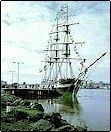Michael In Ireland Cyber Pub | home

An old Irish 1 Pound Note

In 1800, some five million people lived in Ireland. By the autumn of 1845, when the Great Famine struck Ireland, there were more than eight million.
Many of them were wretchedly poor, eking out a precarious living on tiny plots of land, and dependent on each year's potato crop Hunger was no novelty to peasant families, for there had been partial failures of the potato crop in other years. However, these had always been of limited duration, and confined to a small number of counties. The Great Famine lasted from 1845 to 1848, and crop failure affected the whole island.
The cause of the famine was a fungus disease which made the potato plants to rot in the ground, giving off an appalling stench. The blight first destroyed crops on the eastern seaboard of America in 1842, then appeared in England in the summer of 1845. In September, the counties of Wexford and Waterford reported the disease. More than half the Irish potato crop failed in 1845. Sir Robert Peel, the British prime minister, appointed a commission to investigate the problem, but scientists were unable to explain the disease, let alone find a cure In 1846, the potato crop was a total failure.
Peel, to his credit, also introduced relief measures. In November 1845, the government spent £100,000 on buying grain from America, in the hope of keeping food prices down in Ireland. He appointed a relief commission which set about forming local committees to raise money and to distribute food. At Westminster, in part prompted by Ireland's problems, Peel succeeded in repealing the protectionist corn laws in June 1846. This opened up the prospect of cheap imports from America.
 T he Dunbrody Famine Ship Check it out
T he Dunbrody Famine Ship Check it out